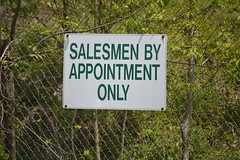Goodreads is a great place to find readers where they’re hanging out online. It’s been one of my favorite sites as a reader to scope out books, compare reviews with friends and keep track of what I’ve read (though I’ve seriously ![]() slacked on that part this year!).
slacked on that part this year!).
But in addition to being a fun place as a reader—and a good place to find new readers by becoming a genuine part of the community—Goodreads also offers several ways for authors to market directly to readers.
Marketing on Goodreads
Naturally, you’ll want to familiarize yourself with the site if you’re not already a member. As an author, you can “claim” your books and have a centralized profile page for readers to learn more about you and your books, and possibly connect with you. You can connect your blog also, so that you have fresh content on your GR page. (However, I’m totally gun-shy about reviews, positive or negative, so if you’re the same way, remember that as you set up your author page. I wonder if there’s an option to hide the reviews from yourself. . . .)
As with all reader communities, behave well. Goodreads has active forums, but spamming them definitely won’t win you any friends, let alone sales. (We covered more about this last week.)
Use the excerpt feature
 Author Elana Johnson blogged earlier this year that Goodreads had added the ability to upload an excerpt from your book, like a free preview for readers. She advises:
Author Elana Johnson blogged earlier this year that Goodreads had added the ability to upload an excerpt from your book, like a free preview for readers. She advises:
I’ve found that a PDF works/looks best, and you can upload the entire book and then choose to only show a certain percentage of it, so it’s probably a 5-minute job to do this.
Then, what I do, is advertise using the word “free” in my ad. Like, “Fans of The Hunger Games and Matched, read the first two chapters of POSSESSION, a dystopian novel, for free.” (Or something more eloquent… But I definitely reference the best-sellers!)
I’ve had over 40,000 views in a single day on an ad like that. And all I did was upload the first two chapters of POSSESSION–which has been free on my website for over a year anyway. But it’s getting it into the hands of READERS in a place where READERS hang out.
Goodreads gives instructions on how to upload your excerpt here.
Goodreads advertising
Goodreads also runs targeted advertising in the right-hand sidebar. I tend to notice the ads most when they’re more dynamic, as opposed to static images. Here’s a static image of a typical dynamic ad in action (the text was moving when I did the screencap):

Personally, I believe these ads are most effective if your “call to action” at the end of the ad is something like “Add [Book] to your To-Read List!” or “Enter the Goodreads giveaway for a free copy” (more on that below)—i.e. they’re fully integrated with Goodreads, and you know that call to action isn’t going to dump you on the Amazon sales page. Plus, adding a book to your digital TBR pile or entering a drawing fora free copy is a lot less of a commitment than even a $0.99 purchase. Finally, when people add books to their To Read list, it shows up in their friends’ news feeds and perhaps email digests of friend activity—more publicity for you.
However, it does seem that few people see a real increase in sales from Goodreads advertising. If you do decide to use their advertising system, I advise making your ads as targeted as possible. Consider targeting people who’ve added (or are currently looking at) books by a similar author, or the like, to truly reach your audience. With such narrow targeting, you’ll reach a smaller audience, but that audience will be more likely to be interested in your book.
Goodreads giveaways
The final aspect of Goodreads that I want to cover is their giveaways. Through Goodreads, you can offer free copies of your book, hard copy or e-book, and people sign up for the giveaway. You set when the contest starts and ends, and all people have to do is click a button in the interim to win one of your free copies. (Want to enter a giveaway? Go to Explore > Giveaways to find the current listings.)

Novel Publicity President Emlyn Chad offers some great advice on maximizing your Goodreads giveaway. Among other points, she says to
- Offer giveaways in multiple countries
- Schedule future giveaways
- Keep the entry period short
She expands on these and eight other interesting tips for more effective giveaways on Goodreads. It seems to be working for her, so if you’re interested in using Goodreads for marketing, definitely check out that article!
What do you think? Are you a member of Goodreads? How do you see it used for marketing, either in a good way or . . . not? Come join in the conversation!
Coming up this week: more last-minute Nano prep, and the starting gun!


